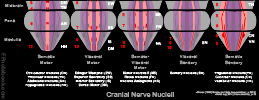Cranial Nerve, Cranial Nerve Anatomy
- Anatomy
- General
- Twelve Cranial Nerves arise from nucleii spread throughout the Brainstem and innervate the head and neck
-
General anatomy of Cranial Nerves
- Cranial Nerves exit the Brain Stem at the anterior aspect (except CN 4)
- Cranial Nerves do not cross the midline (except CN 4)
- Function (differ from spinal nerves which carry both motor and sensory)
- Lesion localization
- Brainstem lesions may be localized, knowing the distribution of Cranial Nerves and their nucleii
- Anatomy
- Cranial Nerve Nucleii by Location
- Images
-
Diencephalon nucleii
- CN 1: Olfactory Nerve (sensory, smell)
- CN 2: Optic Nerve (sensory, eye)
-
Midbrain nucleii
- CN 3: Oculomotor Nerve (motor, eye, Extraocular Movement)
- CN 4: Trochlear Nerve (motor, eye, Extraocular Movement)
-
Pons nucleii (CN 5 nucleus extends into Midbrain, CN 7 and CN 8 nucleii extend into Medulla)
- CN 5: Trigeminal Nerve (mixed, face Sensation)
- CN 6: Abducens Nerve (motor, eye, Extraocular Movement)
- CN 7: Facial Nerve (mixed, face movement)
- CN 8: Acoustic Nerve (sensory, ear, Hearing and balance)
-
Medulla nucleii
- CN 9: Glossopharyngeal Nerve (mixed, mouth, taste, Swallowing)
- CN 10: Vagus Nerve (mixed, mouth/autonomic, taste, Swallowing, speech)
- CN 12: Hypoglossal Nerve (motor, Tongue protrusion)
- Upper Cervical Spine nucleii
- CN 11: Spinal Accessory nerve (motor, neck/Shoulders, head rotation)
- Anatomy
- Cranial Nerves by Function
- Pure motor Cranial Nerves
- CN 3: Oculomotor Nerve (eye)
- CN 4: Trochlear Nerve (eye)
- CN 6: Abducens Nerve (eye)
- CN 11: Spinal Accessory nerve (neck/Shoulders)
- CN 12: Hypoglossal Nerve (motor, Tongue)
- Pure sensory Cranial Nerves
- CN 1: Olfactory Nerve (nose - smell)
- CN 2: Optic Nerve (eye - Vision)
- CN 8: Acoustic Nerve (ear - Hearing)
- Mixed Cranial Nerves
- CN 5: Trigeminal Nerve (face)
- CN 7: Facial Nerve (face)
- CN 9: Glossopharyngeal Nerve (mouth)
- CN 10: Vagus Nerve (mouth/autonomic)
- Autonomic functions (parasympathetic)
- Anatomy
- Bilateral Representation of Cranial Nerve Function
- Unilateral peripheral lesions of Cranial Nerves typically results in unilateral deficits
- Unilateral cerebral Cranial Nerve lesions often do not result in deficits
- Most peripheral Cranial Nerves are innervated by both hemispheres (redundant innervation)
- CN 7 lesion affects the forehead when peripheral (Bell's Palsy) but not in a unilateral cerebral lesion
- However, CN 7 lesion causes contralateral lower face weakness in both central and peripheral lesions
- CN 10 lesion causes Hoarseness when a peripheral lesion, but not in a unilateral cerebral lesion
- CN 8 lesion causes Deafness when peripheral (Cochlear Nerve), but not unilateral cerebral lesion
- Unilateral cerebral lesions do result in deficits in some cases
- Central CN 1 lesions cause ipsilateral Anosmia
- Central CN 2 lesions cause unilateral or bilateral Vision Loss depending on cerebral lesion location
- Central CN 3, 4 and 6 lesions result in oculomotor deficits in both eyes (e.g. both eyes look to the lesion)
- Central CN 5 lesions cause Sensation loss in the contralateral face
- Central CN 7 lesions cause contralateral lower face weakness (but spare the forehead, see above)
- Anatomy
- Images
- See Oculomotor Nerve (Cranial Nerve 3)
- See Trigeminal Nerve (Cranial Nerve 5)
- See Facial Nerve (Cranial Nerve 7)
- See Hypoglossal Nerve (Cranial Nerve 12)
- Cranial Nerve Nucleii
 Lewis (1918) Gray's Anatomy 20th ed (in public domain at Yahoo or BartleBy)
Lewis (1918) Gray's Anatomy 20th ed (in public domain at Yahoo or BartleBy) Lewis (1918) Gray's Anatomy 20th ed (in public domain at Yahoo or BartleBy)
Lewis (1918) Gray's Anatomy 20th ed (in public domain at Yahoo or BartleBy) Lewis (1918) Gray's Anatomy 20th ed (in public domain at Yahoo or BartleBy)
Lewis (1918) Gray's Anatomy 20th ed (in public domain at Yahoo or BartleBy)
- Cranial Nerves Brainstem exits
 Lewis (1918) Gray's Anatomy 20th ed (in public domain at Yahoo or BartleBy)
Lewis (1918) Gray's Anatomy 20th ed (in public domain at Yahoo or BartleBy)
- References
- Gilman (1989) Manter and Gatz Essentials of Neuroanatomy and Neurophysiology, Davis, p. 87-113
- Goldberg (2014) Clinical Neuroanatomy, p. 24-39
- Netter (1997) Atlas Human Anatomy, ICON Learning, p. 110-129
